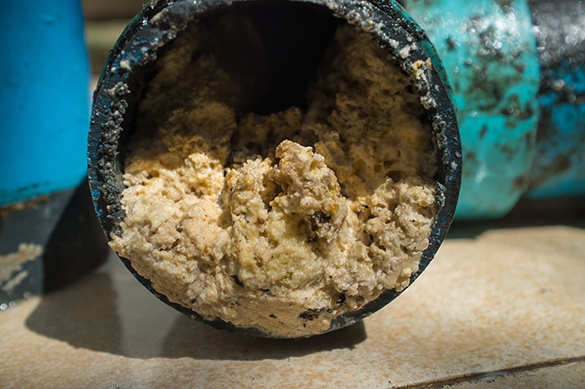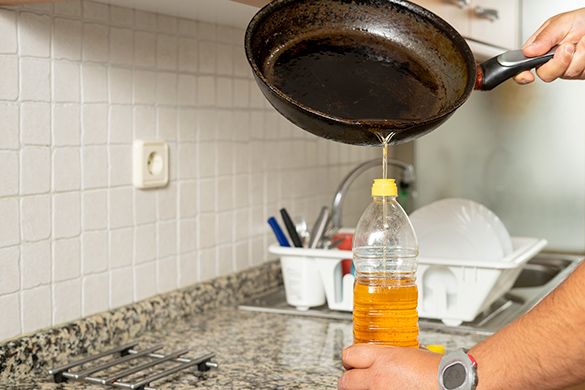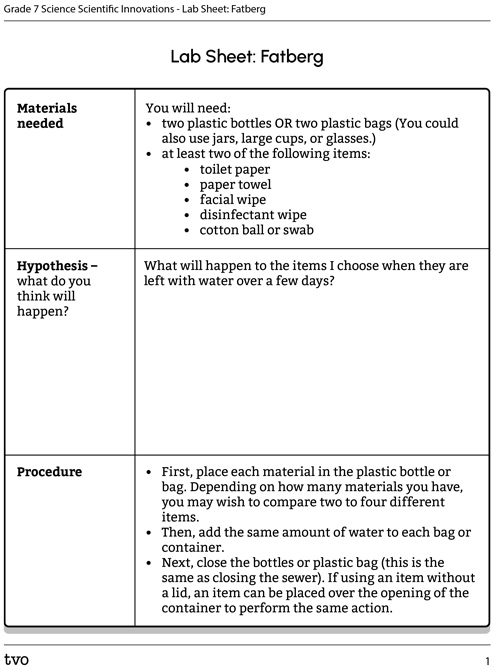Minds On
The sewer system
Check out the following video of boiling vegetable oil.
Brainstorm
Brainstorm
- What happens to cooking grease, oil, or fats when people are done with them?
- What about toilet paper and disinfecting wipes?
- What other items used by people may affect sewer systems?
Record your ideas in a notebook or another method of your choice.
If possible, ask an adult what they do with their grease, oil, or fats when they are done cooking.
Recycling
Check out the following video of sorting recyclable waste.
- What happens to recycling after it leaves a house or building?
- Can you name some of the categories which recycled items may be sorted into?
Record your ideas in a notebook or another method of your choice.
Create an image, detailed description, or an audio clip describing what you think happens to recycling when it leaves a location in your community.
Action
Innovation in Canada
This learning activity features emerging technologies, STEM contributions, and Canadian innovations that are making a difference.

Separating waste
Waste separation is the process of separating waste and recycling it into its different elements.
Historically, recycling was originally all sorted by hand, but because of a growing production of waste, new emerging technologies have been developed to streamline the process and improve the quality of living for the environment.
Through separation, useful waste that can be recycled and reused can be separated to reduce the amount of waste that ends up in landfills.
Press the following tabs to access examples of waste separation and sorting technologies.
Magnetic separation uses different types of magnets to attract magnetic materials. It is mainly used for recovering metal from waste, or separating material from scraps or unwanted substances. Typically, a powerful electromagnet is placed or suspended from a ceiling or device, and materials pass under the magnetic separator. They can also be cylinders those objects pass through.
Check out the following video of magnetic waste separation.
Sensor-based sorting has been used in the food processing and waste/ recycling industries, and has most recently been used in the mining industry. Sensor-based sorting is used when sorting very small particles with the goal to remove waste before it enters production and recover reusable minerals, such as ore.
Check out the following video of sensor-based waste sorting.
Robotic sorting uses coding, artificial intelligence (AI) and robotics to sort plastics. With advanced cameras and technology, many companies are counting on robots to sort recycling. Sensors are able to detect and interact with objects such as cans, glass, plastic, and other recyclable items.
Check out the following video of robotic sorting.
What do you think?
How is technology making a positive impact on the process of recycling?
Refer to the previously explored examples to support your response.
Record your ideas in a notebook or another method of your choice.
Did You Know?
Did you know?
Think about the water that gets used in a house and/or school. Where do you think this water goes?
All water that goes down a drain is called wastewater. 99% of that is water, but what is the other 1%?
That other 1% is made up of things that have been added to the water. Not all of this water makes it to wastewater treatment plants because it gets blocked or overflows because of fatbergs.
A fatberg is a hardened mass of “things” that people put down their sinks, toilets, and drains that should go in the garbage.
They are made up of things like wipes, paper towels, and hygiene products that fats, oils, and grease (FOG) stick to.
Down the drain!
Check out the following Great Lakes Now video entitled “Waters Infected” to learn more about fatbergs.
After exploring the video, you may have noticed that it was recommended that many items are not flushed down the toilet.
- Can you think of any other items that should not be flushed down the toilet?
- Why do you think people shouldn’t flush these items down the toilet or wash them down the drain?
Record your ideas in a notebook or another method of your choice.
Let’s experiment!
It’s time to experiment! In order to understand fatbergs a little more deeply, let’s investigate using the scientific experimentation process.
Explore this video to learn more about the steps of the Scientific Experimentation Process.
Safety
Before you explore the following experiment, let’s perform a safety check.
Hands-on Science
Fatbergs
For this experiment, we will be learning about fatbergs – solid, rock-like buildups that occur in sewers as a result of improper waste disposal methods.
Complete the Lab Sheet: Fatberg in your notebook or using the following fillable and printable document. If you would like, you can use speech-to-text or audio recording tools to record your thoughts.
Press the following tabs to access the materials and procedure for the Fatberg experiment.
You will need:
- two plastic bottles OR two plastic bags (You could also use jars, large cups, or glasses.)
- at least two of the following items:
- toilet paper
- paper towel
- facial wipe
- disinfectant wipe
- cotton ball or swab
- First, place each material in the plastic bottle or bag. Depending on how many materials you have, you may wish to compare two to four different items.
- Then, add the same amount of water to each bag or container.
- Next, close the bottles or plastic bag (this is the same as closing the sewer). If using an item without a lid, an item can be placed over the opening of the container to perform the same action.
- Lastly, record your observations at:
- five mins
- one day
- two days
- three days
- one week
Press ‘Let’s Check!’ to access the final results and conclusions for the explored experiment.
In conclusion, it is important to dispose of items in an appropriate way, rather than dumping them down the drain or flushing them down the toilet.
Explore the following table for more information.
| How do FOGs affect the environment? | What are appropriate ways to dispose of these harmful items? |
|---|---|
|
Sewer pipes run underground from a home or school to a water treatment facility. When incorrect items are dumped down the sink, drain, or flushed down the toilet it causes problems for both individual people and the city. As these items enter the sewer system, they clump together, and cool and harden and stick to the inner walls of the pipes. Over time, this will build up and cause a blockage, eventually clogging the pipe entirely. This can be very costly and difficult to clean out. |
|

|

|
Source: City of Niagara Falls Website. (n.d.). How fats, oils, and grease affect the sewer system: City of Niagara Falls, Canada - city of Niagara Falls. How Fats, Oils, and Grease Affect the Sewer System. Retrieved February 9, 2022, from https://niagarafalls.ca/city-hall/municipal-works/fat-oil-grease.aspx

Science is about reflecting and reimagining. Was your experiment successful?
Is there anything that you would change about your experiment design to improve it or the outcome?
Even if your experiment was not successful, what did you learn or confirm about the topic you were investigating?
Reading Time
Case study
An individual in London, Ontario figured out one way to prevent fatbergs from forming in sewer systems.
Access the article “The Tip of The Fatberg: How London Is Leading The Fight Against An Urban Menace” to explore a case study of this innovative waste technology.

Press tvo today to access The tip of the fatberg: How London is leading the fight against an urban menace.
TVO dot org (Opens in a new tab)After exploring the article, respond to the following questions:
- How is this innovative waste technology reducing the negative impact of humans on the environment?
- Do you think it will effectively continue to make a difference in this community? Why or why not?
Record your ideas in a notebook or another method of your choice.
Consolidation
Review your learning
Select the correct answer, then press ‘Check Answer’ to see how you did.
Advocate!

Now, let’s apply what you have learned about fatbergs, and demonstrate your learning with your oral or written communication skills to create a public service announcement (PSA) that informs people about it.
It should also explain what materials should and should not be flushed down the toilet.
Choose one of the following options to create your PSA:
- create a video
- create an announcement or radio ad
- write a letter to community members
- another method of your choice
Consider the following checklist to guide your PSA.
If possible, share your public service announcement with a partner.
Reflection
As you read the following descriptions, select the one that best describes your current understanding of the learning in this activity. Press the corresponding button once you have made your choice.
I feel…
Now, expand on your ideas by recording your thoughts using a voice recorder, speech-to-text, or writing tool.
When you review your notes on this learning activity later, reflect on whether you would select a different description based on your further review of the material in this learning activity.
